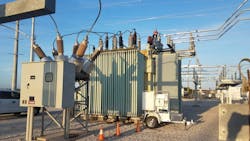Leveraging Online DGA to Optimize End-of-Life Operations for Aging Power Transformers
The Importance of Power Transformer Monitoring
No utility wants to take a transformer out of service because of an unforeseen fault condition. Due to this critical importance — and the high cost and lengthy lead times for replacements — there is a relatively quick payback on monitoring that detects problems in these transformers as early as possible. Effective early monitoring enables decision-makers to work around planned outages to complete necessary maintenance in a scheduled manner, avoiding sudden failures and electricity outages that create safety risks and incur unnecessary costs.
After years of service, transformer failure can occur due to several reasons, including:
Electrical breakdown or disturbances, such as a through fault.
Dielectric, mechanical or thermal stresses causing winding failure.
Deterioration of the insulation’s dielectric integrity.
Overloading, whether planned or unplanned, short— or long-term.
Inadequate maintenance, such as loose connections, insulating fluid leaks and cooling systems.
Failure of accessories like OLTCs
Bushing failure stemming from transformer vibrations, partial discharge or dielectric losses due to seal breaks.
Cooling system failure.
Lightning strikes.
Whether it is age, increased and varied load levels, or network disturbances, these factors all take their toll on transformers, leading to an increased risk of unpredictable faults and outages. Since the majority of these problems can be detected with DGA monitoring, most operators will install online DGA monitors on the most critical assets and take DGA lab samples on a regular basis on all other assets. However, maintenance teams need a mobile online DGA solution when these labs indicate a fault.
Whether fixed or mobile, real-time online DGA monitors mitigate the risks associated with transformer failure and safeguard critical assets, meaning utilities can — and should — leverage such instruments to detect and identify transformer faults by looking at the key fault gasses and their trending patterns.
Stay Ahead of Unforeseen Outages and Failures with Online Monitoring Solutions
Power companies typically monitor fluctuations in transformers and their electrical distribution system by assessing various parameters to predict and prevent the failure of critical transformers. One of the key parameters is the quality of the insulating oil. Traditionally, standard oil sampling procedures are carried out only once or twice a year. However, if a transformer is not “healthy” and shows signs of dysfunction based on DGA measurements from software tools or lab consultants, testing frequency increases to as often as every two to four weeks. However, this “offline” sampling methodology never will give real-time insight, which could help make the necessary decisions about the operational health and safety of the unit.
Online monitoring of dissolved gases and moisture in power transformers provides real-time data that can be compared to operating conditions to do a more thorough and fact-supported analysis of the transformer condition and provide early warning of developing transformer fault situations. This enables maintenance and asset managers to make informed decisions to maximize the safe performance of the transformer and support the planning of efficient maintenance while minimizing outage time and safety and operational risk.
Monitoring the key fault gasses dissolved in the transformer oil helps determine the types of pending or occurring faults within power transformers because the generation of these key fault gases will indicate a fault and its potential cause. That is why DGA monitors measure hydrogen (H2), methane (CH4), ethane (C2H6), ethylene (C2H4) and acetylene (C2H2). These key fault gasses begin to form at specific temperatures and during certain fault conditions and so appear as dissolved within the insulation oil of a power transformer. The types and quantities of the gases that form will depend on the nature and intensity of the fault.
The advantages of DGA monitoring include:
Advanced warning of developing faults.
Status checks on new and repaired units.
More efficient scheduling of maintenance and repairs.
Monitoring units under potential overload/variable load conditions or nearing their end-of-life operations for fast-developing faults.
Consider the case of a Texas utility that had a transformer approaching its end of life as an example of how DGA provides insight into an aging transformer, enabling the identification of a fast-forming fault before it blew the transformer.
Safeguarding End-of-Life Operations with Online DGA
Exploring the detection of severe faults and the overall monitoring process and procedure of a critical 100-MVA transmission transformer into its final months in service, this case illustrates how the utility used online DGA to help systematically monitor, then remove and replace the transformer before it experienced any major operational failures or exposed staff to safety risk.
Manufactured by Pennsylvania Transformer in 1958, the aging transformer operated without significant issues for its first 50 years until 2010, when the first questionable gassing patterns appeared in the DGA sampling. While the transformer remained stable until 2013, an unknown event caused significant gassing. The transformer's ethylene increased from 35 parts per million (ppm) to 100 ppm in just a few weeks. Based on the gases formed, a high-temperature fault in oil was initially suspected. However, after this initial event, the situation returned to a relatively stable condition, so no immediate action was taken. Lab sampling then showed another event in 2017, but again, the event did not seem to lead to ongoing gassing, so the unit was degassed and moved to a new site in 2018. Then in May 2019, problematic DGA patterns at the new location were found in the sampling again. A visual inspection showed some carbon formation, but the unit was returned to service.
A key challenge was interpreting the gassing patterns and the severity of the fault events due to the offline lab sampling frequency. The sampling occurred so infrequently that it was impossible to know the exact event timing and the degree of change, which would have shown the severity. But it was clear there were issues, and the transformer was reaching its end of life. To best assess and monitor this aging transformer in real time, the utility installed the Vaisala OPT100 Mobile online DGA device in October 2019.
Vaisala’s OPT100 Mobile monitor measures the seven key fault gases and the moisture in the transformer oil and utilizes total gas pressure for leak detection on sealed transformers. This is a mobile online DGA monitor, so the utility could easily and rapidly deploy online DGA monitoring equipment, allowing the maintenance and asset health teams to follow the gassing patterns more closely and ensure the safe use of the transformer until its replacement.
The online monitor data revealed that the aging transformer’s gassing patterns were not a steady incremental increase but started with clear steps, suggesting separate incidents. This theory was further supported by comparing gassing to loading in real time. Since no correlation was observed, the loading did not appear to be causing the fault gas generation. Then in January 2020, the online DGA monitor showed a continuous and accelerated increase in gas formation — a clear indication that the fault was evolving and becoming more severe and unsafe to operate. This led to a planned decommissioning of the transformer.
Like the earlier laboratory DGA results, the data from the online DGA monitor showed that the carbon monoxide (CO) and carbon dioxide (CO2) levels remained stable throughout the monitoring period, indicating that insulation paper was not involved in the fault events. However, ethylene was a dominating gas throughout the monitoring, indicating that the transformer has a thermal fault of some type.1 Most importantly, by leveraging the real-time online measurements of the key fault gas data from the online DGA monitor, the Texas utility could understand the very high risk of imminent failure and proactively take corrective action.
Conclusion
As this case clearly illustrates, online DGA monitors provide utilities with the necessary information to safely operate critical equipment and power transformers with evolving faults. This real-time monitoring information empowers maintenance managers with information to ensure performance and, when needed, initiate timely maintenance plans to prevent physical, employee, environmental, financial or reputational damage resulting from an unexpected outage.
With online real-time condition monitoring, utilities can keep power transformers operating safely and with maximum efficiency — even when a transformer is nearing its end of life — extending the operational lifetime and preventing unexpected and costly outages. And while offline DGA sampling can identify potential internal faults, only continuous online DGA monitoring tools can both detect gassing in real time for better comparison and better reveal the actual gassing patterns, enabling better fault identification and deeper analysis.
The information online DGA monitors provide is highly valuable for asset and maintenance managers who need to make timely maintenance action decisions. They need to have an in-depth understanding of the assets’ technical life and current condition, as well as the required next steps, particularly if a fault requires immediate maintenance actions or potential replacement. So, when leaving a power transformer in service that is suspect due to offline DGA testing or aging risk, online DGA monitoring can help assure maintenance teams that it is safe to keep operating while in active fault status.
Online DGA monitoring of aging transformers in their end-of-life or “active fault development” phases are one of the key tools to provide utility operators the peace of mind to safely operate these transformers until repair is feasible or a replacement is required. With new mobile online DGA tools, the DGA process is becoming easier to manage. As we all know, there is nothing worse than an unplanned outage that could have been avoided. Leveraging mobile online monitoring tools, like the Vaisala OPT100 Mobile, more precisely and effectively analyzes and monitors transformer faults in these critical assets to ensure employee safety and operational continuity.
About the Author

Mark Gross
Mark Gross, regional business manager for the Vaisala Power Solutions group, has more than 25 years of experience working in the power generation, renewable energy and green/high-tech industries, holding key roles in various companies in the alternative energy and sustainable fuels segments in both the U.S. and Latin America. He has also worked extensively with new markets, market research and development, looking at new technologies and applications in the green technology and energy/power sectors


